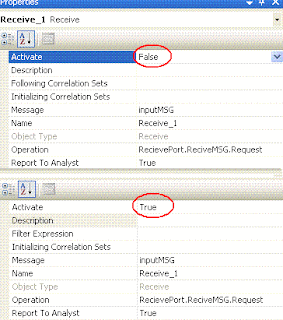He said,"haaaaa????!!!!!"

Trying to explain, I talked to him about the world-wide need of many organizations to integrate their enterprise applications. I told him some concepts like(Service-Oriented Architecture (SOA), Message-Oriented Middleware (MOM), methodologies (Business Process Management-BPM, Business Process Reengineering) and standards (XML, XSD, Rosetta.NET) as well as the advent of emerging technologies such as Web Services stack of protocols (WS-*), Enterprise Service Bus (ESB) and others, then vendors have released their own solutions and thus organizations have achieved their challenging goals of automation of business process by the integration of their Information Systems. In this arena, we can find fundamentally two important products: Microsoft BizTalk Server 2004/2006 and Oracle SOA Suite."
I thought he said inside him, "Ummmm…..seem that someone will be killed tonight"

I told him, "Wait man , I got a very simple definition of BizTalk Server which is Microsoft's central platform for Enterprise Application Integration (EAI) and Business Process Management (BPM) that embodies the integration and automation capabilities of XML and Web Services technologies. "
He screamed and said, "STOP!!!!!" 
And carrying and said in a weak voice "Please, I need to know what BizTalk is!" 
After I told him I know how can I explain this, he calmed down. I found that the most important terms that BizTalk depend on are: Business Process Management (BPM), Enterprise Application Integration (EAI) and finally, Service Oriented Architecture (SOA).
I told him , Man what if I told you that "What will you say that if the organization need a disciplined approach to identify, design, execute, document, monitor, control, and measure both automated and non-automated business processes to achieve consistent, targeted results consistent with an organization's strategic goals."
He said, "Of course this approach will help them to better manage their business processes"
I told him, "This is the BPM, beside there are many vendors who created application suites which enable organizations to better manage their business processes. These technologies typically involve tools to visually design and model business processes; simulate and test business processes; automate, control and measure business processes; and provide feedback and reporting on process performance. Some vendors have combined these functions into business process management suites that provide a complete integrated BPM platform, commonly referred to as a BPMS"
I GOT A POINT
I told him again, and what if I told you that many organizations have a large number of legacy systems, typically designed to support specific functions such as manufacturing or sales. In order to manage the end-to-end work involved in business processes, a BPMS must be able to integrate with legacy systems across the organization in order to control work, get information or measure performance. A variety of new technologies have emerged to simplify integration efforts and the technology industry appears to be standardizing on a specific set of open technologies, commonly referred to as Web Services. And By leveraging web services, organizations can build and manage end-to-end business processes across organizational silos and their legacy systems."
He said, "Oahu…this is a good architecture ".
Note: he said the term architecture
I told him this architecture called means a common framework for how these technologies are deployed is also being adopted, most often referred to as a Service Oriented Architecture (SOA).
I GOT ANOTHER POINT
Finally, I told him again, and what if I told you that EAI is the unrestricted sharing of data and business processes throughout the networked applications or data sources in an organization. You know that early software programs in areas such as inventory control, human resources, sales automation and database management were designed to run independently, with no interaction between the systems. They were custom built in the technology of the day for a specific need being addressed and were often proprietary systems. As enterprises grow and recognize the need for their information and applications to have the ability to be transferred across and shared between systems, companies are investing in EAI in order to streamline processes and keep all the elements of the enterprise interconnected."
He said, "Well this is a good thing to help my enterprise applications to run independently"
Congratulation Sir!!!! You had understood the BizTalk server right now. 
Conclusion:
Then after this story we can say that BizTalk is a product developed by Microsoft to enable companies to automate and optimize business processes. This includes powerful, familiar tools to design, develop, deploy, and manage those processes (BPM). BizTalk not only used to integrate enterprise applications with each other (SOA) and (EAI), but also automate, control and measure business processes; and provide feedback and reporting on process performance and define and run your business rules dynamically.

















